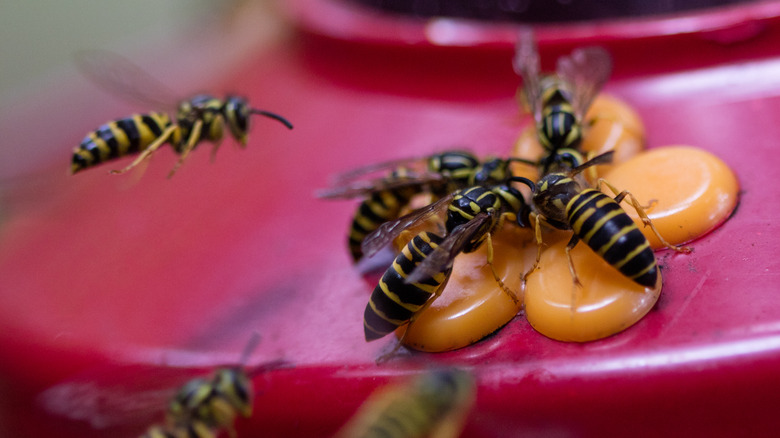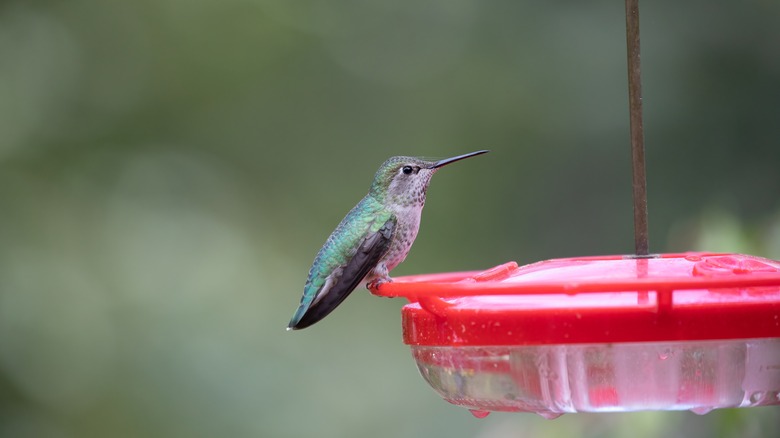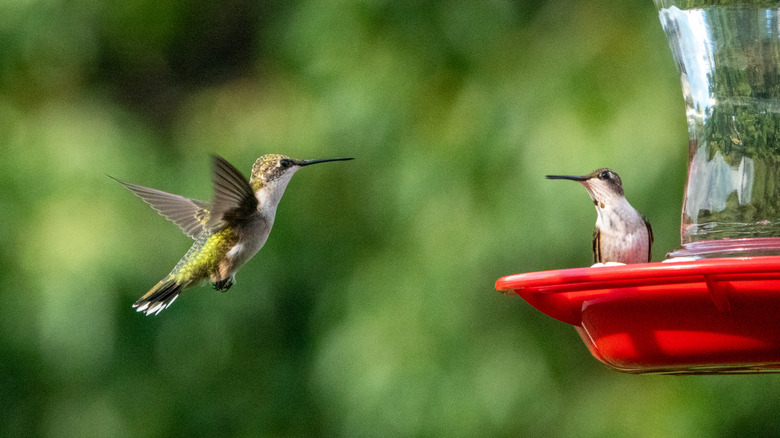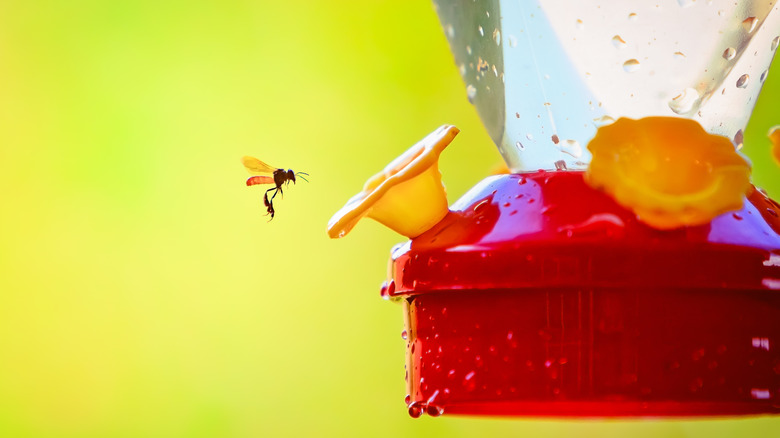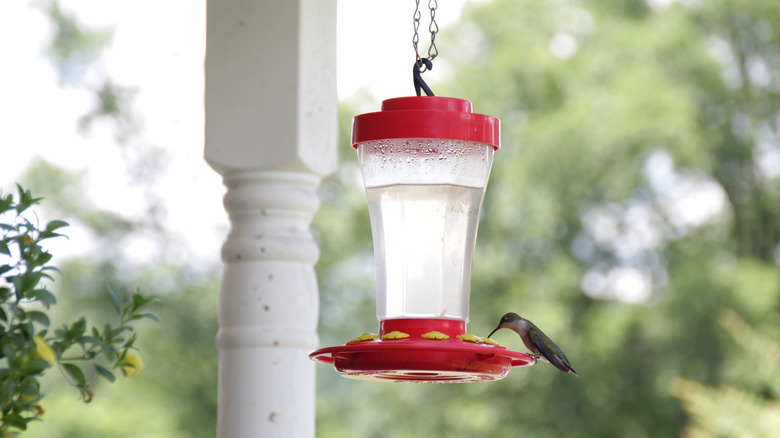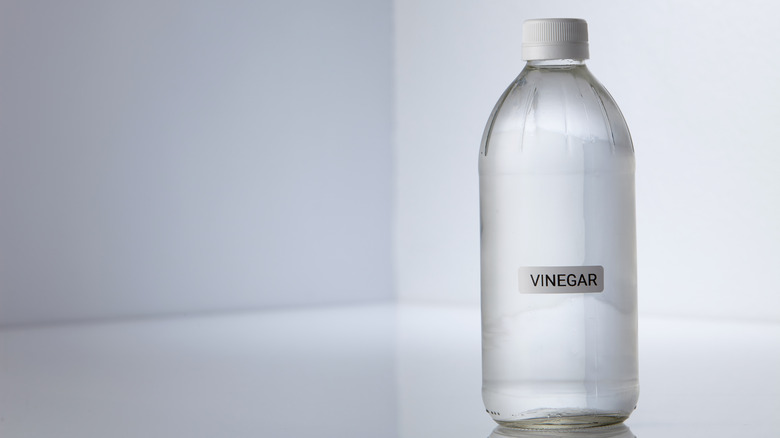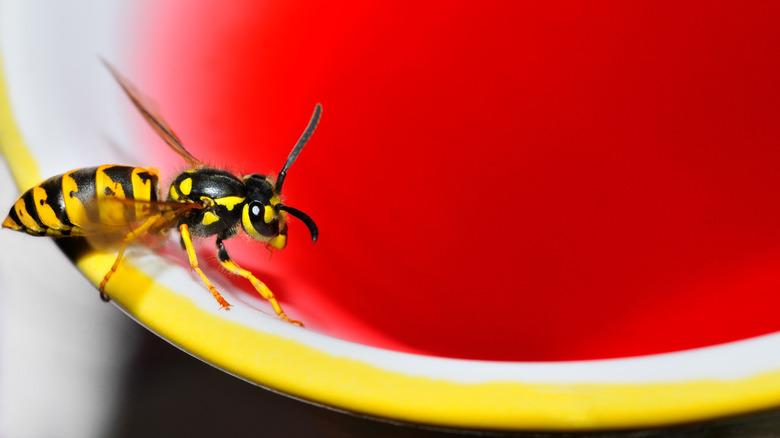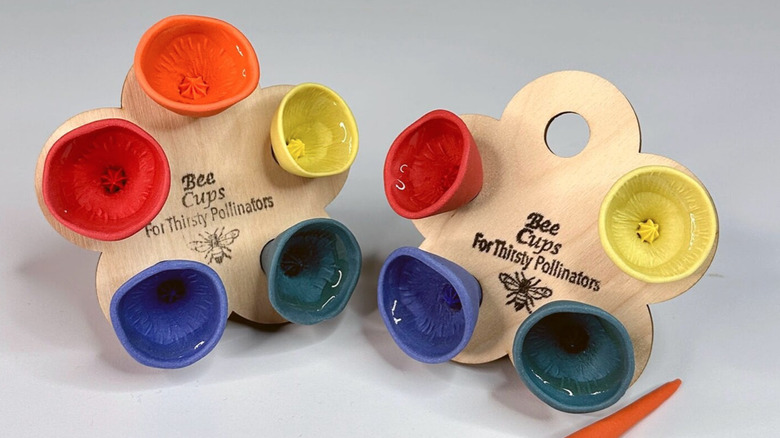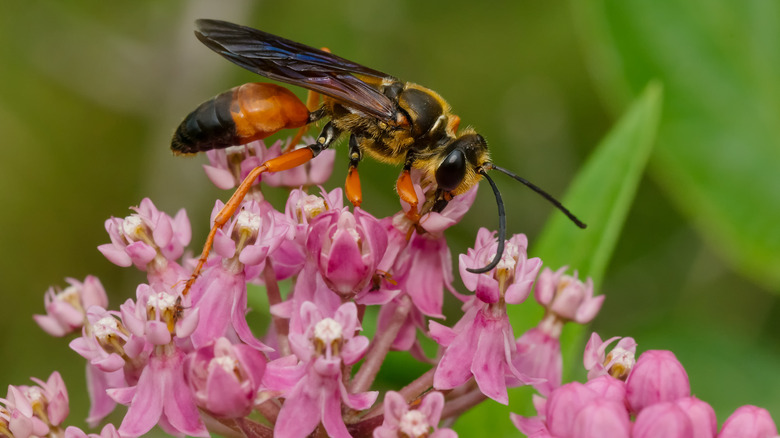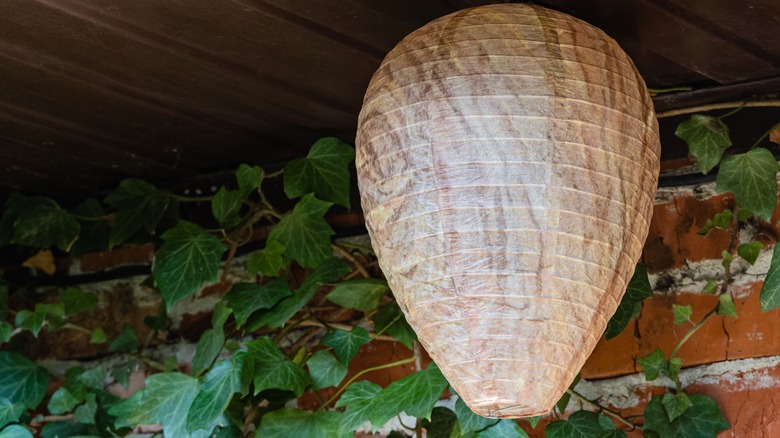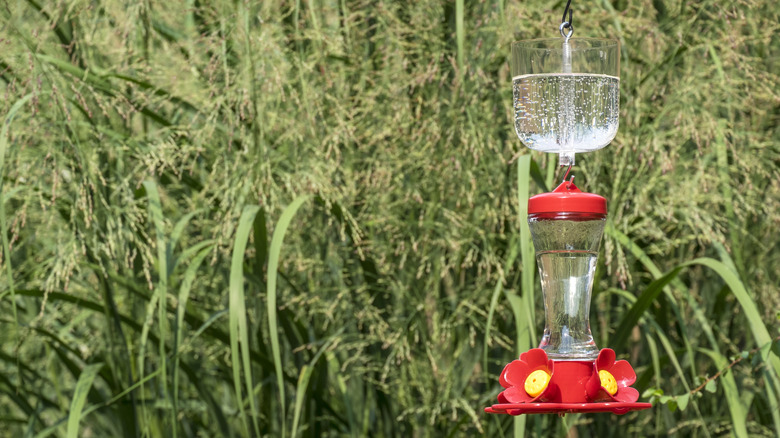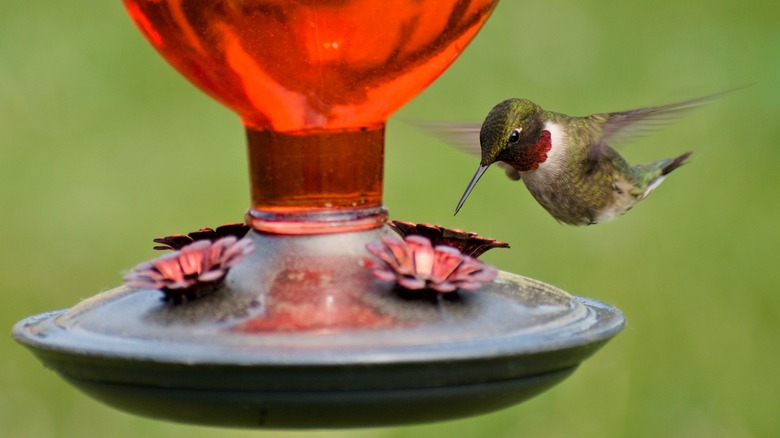Helpful Tips To Keep Wasps Away From Your Hummingbird Feeder
We may receive a commission on purchases made from links.
If you enjoy watching your hummingbird feeders lure these elusive birds to your yard, but you don't like dealing with the wasps that visit as well, check out these tips for deterring them. Wasps get a bad rap and are often labeled as backyard pests. However, these predatory insects are important members of the ecosystem. They can even help keep your garden pest population in check by eating other bugs. That said, these insects love the sweet taste of nectar as much as any other pollinator. Translation: where there's a hummingbird feeder, there will likely be wasps.
Despite their beneficial presence in the garden, wasps can pose an inconvenience to humans or feeding birds when many of them crowd the feeders. It's better for your yard if you don't focus on eliminating wasps from your yard altogether. Instead, the best course of action is to limit their presence at the feeder by encouraging them to find other food sources. Here, you'll find several approaches that can help reduce the number of wasps gathered at the hummingbird feeder, while still benefiting from their presence elsewhere in your yard and garden.
Use saucer hummingbird feeders
Switching the type of hummingbird feeder you're using could reduce the number of wasps you see buzzing outside. There are two main types of hummingbird feeders: saucer feeders and inverted or vacuum feeders. Saucer feeders have a reservoir at the base of the feeder covered by a plate with holes where birds can dip their beaks and draw up nectar. The feeder is filled by removing the plate, filling the base with nectar, and replacing the plate. On the other hand, inverted or vacuum feeders feature an inverted bottle with a vacuum seal that doles out nectar to a few ports along the bottom of the feeder.
In inverted, or vacuum feeders, nectar often sits closer to the top of the ports than in saucer feeders. This means that wasps have a harder time accessing nectar in saucer feeders. Some bird enthusiasts swear by not filling their saucer feeders all the way so the nectar sits even farther from the surface. That way it's accessible to hummingbirds' long beaks but out of reach of wasps.
Add nectar guard tips to deter wasps
Wasps are drawn to the sweet nectar on offer at your hummingbird feeder, sometimes even crawling inside the feeder's ports to drink the stuff. However, when the nectar is harder for wasps to access, they may leave the feeder altogether and search for other food sources that require less effort to reach. That's why many hummingbird watchers install nectar guard tips (sometimes called bee guards) like these from Amazon. Bee guards regulate access to nectar and drive wasps and other insects away.
Nectar guards are small plastic pieces that can be placed in the feeder ports. The result is that the size of the feeding hole is reduced and wasps are prevented from crawling inside and feasting. Meanwhile, the nectar port is wide enough for the hummingbird's narrow beaks and tongues to continue to access the sweet food. Nectar guards can be purchased separately from the hummingbird feeder. They are replaceable if they wear out due to prolonged exposure to the sun and other elements.
Avoid wasp-attracting yellow markings on feeders
Like other pollinating insects, wasps see a different spectrum of colors than people see. Wasps are most attracted to yellow and white, which resemble some of the flowers they like to eat from, like goldenrod or dogwood. On the other hand, they have a hard time seeing the color red. Luckily, hummingbird feeders are usually red (because the petite flyers are attracted to the color), which is ideal for limiting notice from wasps.
Less luckily, though, some feeders and nectar guards have yellow accent colors, especially around the feeding ports. So, try to minimize the yellow markings on your hummingbird feeders. If you buy nectar guards, choose models that are red or clear in color instead of yellow when available. Also, take note of the colors present around your hummingbird feeder. If there are white or yellow flowers or decorative elements nearby, consider moving the hummingbird feeder to a different location where it may attract less notice from wasps.
Move your hummingbird feeders periodically
Wasps are clever creatures and when it comes to finding food they like to work smarter, not harder. Translation: If there's an easy meal to be had at a hummingbird feeder, you can bet they'll choose that over pollinating your flowers. For that reason, hang your hummingbird feeders at a distance from your flower beds to not lure winged guests away from your garden. However, if wasps have already found your feeder, you can still put them off the scent of an easy meal.
Wasps will likely return to the same food source for as long as they're able. But, experts explain that you can throw them off by moving or temporarily removing the feeder they've been flocking to. Hummingbirds will still look for it, while wasps may be more easily contented with finding another food source nearby. Relief isn't permanent, so you may want to move feeder locations every few days. You may even consider taking it inside if you have many wasps in your yard. Wash the feeder, and wait a couple of days to allow the wasps to disperse and move on. Then refill the feeder and place it back outside in a new location.
Clean the feeder (and the area around it) regularly
Let's state the obvious: You should be cleaning your hummingbird feeders regardless of any wasp issues. The Audubon Society suggests emptying and cleaning hummingbird feeders weekly, or each time you refill them, during the colder months. Then, double the frequency to twice weekly during warmer seasons. The main reason to do this is to keep feeders clean and free of mold and reduce the risk of illness to birds.
Bird benefits aside, keeping feeders clean can also limit wasps. Sweet spills and mess attract wasps, so keep the feeder and the area around it clean. If sugar water pools on the ground or drips down a wall, take a hose to the area. When cleaning feeders, hot water is usually enough to do the job. However, you'll want to avoid common mistakes when cleaning your hummingbird feeder. For instance, don't forget to take them apart to thoroughly clean all of the parts, and avoid using harsh bleach. Instead, use a gentle vinegar dilution to keep hummingbirds safe and healthy.
Give wasps their own feeding station
If you can't beat 'em, feed 'em! Wasps are looking for nourishment, plain and simple, just like any other animal would. With that in mind, you can give them a food source that distracts them from your hummingbird feeder. Mix up a sugar water mixture, just as you would when refilling the hummingbird feeder. Then, place the nectar in a shallow bowl. Pick an orange or yellow bowl, if possible, as these colors are most attractive to wasps. Set the bowl outside in a sunny spot that's far removed from the hummingbird feeder but still accessible to wasps. Take the bowl inside occasionally to wash and refill it, then return it to the same area. Now it can continue serving as a decoy to draw wasps away from your hummingbird feeder.
If you don't want to bother with dedicated wasp feeders, you may also consider adding multiple hummingbird feeders to your yard. The feeders may still draw wasps, of course. However, having two or three extra feeders nearby should ensure that hungry hummingbirds can still access at least one without being deterred by the insects. Remember, you'll still need to wash your feeders, so don't install more than you want to clean.
Put out water for wasps to drink instead
Wasps, like bees and butterflies, need water to survive. They drink it, of course, but they use it for much more besides that. Elizabeth Tibbets, an ecology and evolutionary biology professor at the University of Michigan, explains to National Geographic that wasps "mix water with wood pulp to construct their nest, use water for cooling their nest on hot days, and share construct their nest, use water for cooling their nest on hot days, and share the water with nest-mates and larvae."
Use this insect's biological needs to your advantage by attracting waster-seeking wasps to areas far away from the hummingbird feeder. This can be made easy by placing Bee Cups in your garden. These are small shallow dishes that hold a small amount of water intended for pollinators. Alternatively, you can make a DIY mason jar waterer to serve a similar purpose. Another option is to add a bird bath with some stones or marbles in the basin to make it easy for insects to perch and drink. As an added benefit, water sources will service other pollinators that beautify your yard.
Plant native pollinator plants to distract wasps
Wasps are pollinators and pollinators like sweet food. You can bet that the same instincts that draw wasps to the hummingbird feeder will attract them to a pollinator garden. The best plants for a pollinator garden are native species. Some of the favorite plants of wasps are milkweed, goldenrod, and Queen Anne's lace. If you keep a vegetable garden, consider adding these plants in and around your crops to draw pollinators where you need them to increase yield.
There are other benefits to adding pollinator plants to your yard. By drawing wasps away from the feeder and into the garden, you'll encourage them to frequent areas where their predatory instincts can help manage your insect population. Plus, the additional flowers will be attractive to native bees and butterflies and, yes, even hummingbirds. Avoid applying pesticides on or near pollinator gardens to keep winged visitors healthy and able to contribute to your backyard ecosystem.
Don't bother with decoy wasp nests
There's a common belief among homeowners that says if you hang a decoy wasp nest, you'll deter territorial wasps from nesting nearby. Some hummingbird watchers, in turn, hang decoy wasp nests near feeders to signal to wasps that this spot is taken. There's certainly no harm in placing a decoy wasp nest near your hummingbird feeder, but if you think it will do much to deter hungry wasps, dare to dream.
One type of wasp commonly seen at hummingbird feeders is the yellowjacket. Yellowjackets, while territorial, are ground-nesting wasps. So, they won't see a hanging wasp nest as a challenge. Even wasps that build paper nests may not be deterred by decoys. After all, it's not uncommon to see multiple wasp nests built close together in the wild. So, in short, save your money for products that will do what they advertise.
Don't rely on hummingbird feeder ant moats
An ant moat is a plastic piece that can be filled with water and added to a hummingbird feeder to deter crawling insects. On hanging feeders, ant moats are added above the feeder. This prevents ants that crawl up a wall or pole from crawling down the feeder. Some stick-on window hummingbird feeders come with an included ant moat.
Buying or DIYing an ant moat is a fine idea if you want to keep out crawling insects. However, deterring flying insects is another matter. While it's not outside the realm of possibility that a wasp could get caught in a water moat on accident, it's not a viable solution to a wasp problem. Since they access a hummingbird feeder by air, they're able to dodge impediments made for those who travel by foot. If you're buying add-ons for your feeder, skip the ant moat and try nectar guards instead.
Don't use oil or petroleum jelly
Some pest prevention guidance advises people to deter bugs with oil-based products like petroleum jelly or essential oils. It is never wise to use oils to eliminate one species when these substances may harm a non-target species. So, avoid applying products like these to bird feeders and surrounding areas.
Some essential oils are toxic to birds (and, indeed, many animals). So don't spray these on or around hummingbird feeders, even if your intention is to chase away wasps. While it's true that wasps don't like the scent of some essential oils, it's also true that the substances can make hummingbirds sick. Don't bother smearing petroleum jelly on a hummingbird feeder pole or on other surfaces nearby. While some DIY pest prevention sites recommend this, the downside is that hummingbird wings can come into contact with these surfaces. This leads to oils weighing down their feathers. Instead of deploying these counterproductive tactics, focus on safer, more effective measures.
